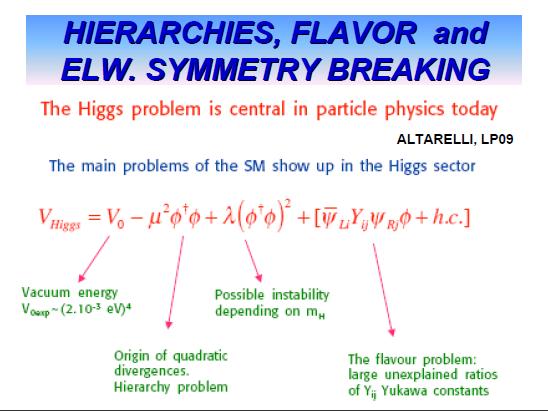
The slide, inspired by a note by Altarelli at the Lepton-Photon conference this year, summarizes in a strikingly concise way one simple concept: much of our theoretical troubles in the Standard Model nowadays have origin in the Higgs potential V, i.e. the formulation of the energy associated with the Higgs field in the Lagrangian density function of electroweak theory: the complicated-looking expression in red above. There are (at least) four emergent problems:
1) the vacuum energy is the constant term in the expression. Its magnitude is a real puzzle, since it is off by orders and orders of magnitude with respect to what one could expect.
2) the fine-tuning of the Higgs boson mass is a second problem, related to the fact that this parameter receives very large contributions from radiative corrections of either sign in the theory: as Michelangelo Mangano says, if you are given ten random irrational numbers between -1 and 1, you would think there's something fishy if their sum turned out to be 10^-32.
3) the shape of the Higgs potential V depends on the value of the parameter lambda and the Higgs mass, and in some cases it develops an instability -the vacuum is not the vacuum anymore because there is no minimum for some values. I have discussed the issue here in some detail recently.
4) and then there is the puzzle of why the Yukawa couplings of the Higgs to fermion fields are so widely different. The coupling to the top quark is of order unity, the ones to neutrinos are tiny.
The temptation to wipe the whole part of the SM Lagrangian off the board is there, admittedly. But then, how do we make things work without a Higgs ? How do we explain the fact that electroweak parameters have the value we measure ? And how do we get those fermion and boson masses anyway ? This is one of the crucial questions of fundamental physics today.



Comments